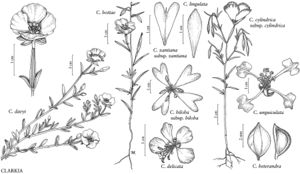Clarkia heterandra
Madroño 39: 163. 1992.
Stems erect, to 60 cm, glandular puberulent. Leaves: petiole 5–20 mm; blade lanceolate to ovate, 2–8 cm. Inflorescences open racemes or panicles, axis straight; buds erect. Flowers sometimes autogamous; floral tube 1–2 mm; sepals reflexed together to 1 side; corolla rotate, petals elliptic to obovate, tapered to claw; stamens 8, unequal, anthers cream or light pink, inner ones smaller, sterile; ovary subglobose, grooves obscure; stigma not exserted beyond anthers. Capsules 2–3 mm, indehiscent, nutlike; sessile or pedicellate (to 2 mm). Seeds 1 or 2. 2n = 18.
Phenology: Flowering May–Jul.
Habitat: Shady sites, woodlands, yellow-pine forests.
Elevation: 500–2000 m.
Discussion
Clarkia heterandra occurs in southern Oregon and California, where it is known from the Klamath Ranges in Trinity County, widely in the Sierra Nevada and Tehachapi Mountain area from Nevada to Kern counties, and in the South Coast and Transverse Ranges from San Luis Obispo to Riverside and San Bernardino counties.
Prior to 1986, Clarkia heterandra was treated as the monotypic genus Heterogaura, thought to be possibly related to the genus Gaura (now a section of Oenothera) due to its similar indehiscent fruits. However, molecular data indicate that C. heterandra is clearly within Clarkia, most closely related to C. dudleyana and C. unguiculata, which suggests a possible hybrid origin at the diploid level (K. J. Sytsma and L. D. Gottlieb 1986, 1986b; W. L. Wagner et al. 2007). Clarkia dudleyana and C. unguiculata produce spontaneous hybrids when grown adjacent to each other if they come from allopatric populations.
Selected References
None.
